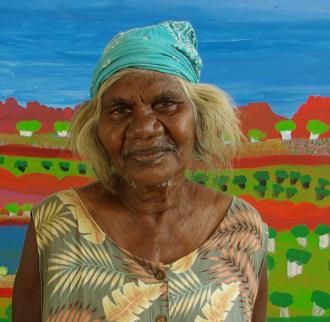Date of Birth:01.07.34 Language:Walmajarri Country:Cherrabun Station I was born at the creek near the homestead on Cherrabun Station.
I grew up on the station.
My father used to work there.
Sometimes he would run away with us kids and his three wives.
When this happened the police would come and pick us up.
One time they put chains around his neck and made him walk from Cherrabun Station to Bayulu and from Bayulu to the police station at the Old Crossing in Fitzroy Crossing.
He was chained to a tree with some of the other men.
I saw them with my own eyes.
We camped near the police station because my father was there.
I learnt to work on the station cleaning and cooking.
We used to work for tea, sugar, flour, tobacco, blankets and clothes to wear.
My father went to pick up families that were taken from their country by the police and Aboriginal trackers.
People used to cry for their country but we told them, “don’t cry, think about your country”.
When I paint I think a lot about my mother and father when they were living in the desert.
I went to visit my mother and father’s country.
I was feeling sad, it made me sorry.
When I first went to Kaningarra I didn’t know that place.
They told me, “you should go and see your parent’s country”.
I was really broken in my heart.
I was really sad.
I knew all of my family had been there.
I first went when I was an old woman.
From Kaningarra they travelled right up to Lake Gregory.
When I went there I was thinking to myself, “why am I going to see this country?” I was very sad just travelling and looking at this beautiful country.
I was crying at Kaningarra.
People were killed there by the policemen.
That’s why my parents left Kaningarra.
Collections: Australian National Gallery National Museum of Australia National Gallery of Victoria Telstra Collection, Museum & Art Gallery of the Northern Territory North Australian Research Unit, ANU Queensland Art Gallery Karrayili Adult Education Centre Berndt Museum, University of WA Leg Assembly of WA Fitzroy Crossing High School Fitzroy Crossing Hospital Brian Tucker Private Collection Charles Darwin University, NT
.Date of Birth:01.07.34 Language:Walmajarri Country:Cherrabun Station I was born at the creek near the homestead on Cherrabun Station.
I grew up on the station.
My father used to work there.
Sometimes he would run away with us kids and his three wives.
When this happened the police would come and pick us up.
One time they put chains around his neck and made him walk from Cherrabun Station to Bayulu and from Bayulu to the police station at the Old Crossing in Fitzroy Crossing.
He was chained to a tree with some of the other men.
I saw them with my own eyes.
We camped near the police station because my father was there.
I learnt to work on the station cleaning and cooking.
We used to work for tea, sugar, flour, tobacco, blankets and clothes to wear.
My father went to pick up families that were taken from their country by the police and Aboriginal trackers.
People used to cry for their country but we told them, “don’t cry, think about your country”.
When I paint I think a lot about my mother and father when they were living in the desert.
I went to visit my mother and father’s country.
I was feeling sad, it made me sorry.
When I first went to Kaningarra I didn’t know that place.
They told me, “you should go and see your parent’s country”.
I was really broken in my heart.
I was really sad.
I knew all of my family had been there.
I first went when I was an old woman.
From Kaningarra they travelled right up to Lake Gregory.
When I went there I was thinking to myself, “why am I going to see this country?” I was very sad just travelling and looking at this beautiful country.
I was crying at Kaningarra.
People were killed there by the policemen.
That’s why my parents left Kaningarra.
Collections: Australian National Gallery National Museum of Australia National Gallery of Victoria Telstra Collection, Museum & Art Gallery of the Northern Territory North Australian Research Unit, ANU Queensland Art Gallery Karrayili Adult Education Centre Berndt Museum, University of WA Leg Assembly of WA Fitzroy Crossing High School Fitzroy Crossing Hospital Brian Tucker Private Collection Charles Darwin University, NT
.